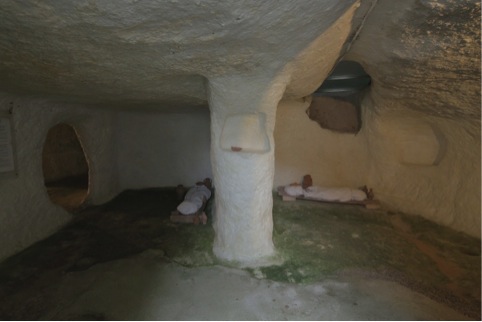The funeral ritual
In the Punic necropolis of Sant'Antioco, the dead were buried according to a typical ritual.
The Punic funeral ritual required first that the body of the deceased should be washed, then subsequently sprinkled with scented oils and ointments. The body was then dressed in a tunic or wrapped in a shroud, and embellished by completing the dressing with the jewellery he owned when alive. The accessories used for the daily care of the body were also buried along with the deceased together with the amulets which it was believed would guarantee a peaceful transition to the afterlife, such as scarabs carved in hard stone, small pendants depicting Egyptian gods, thin sheets on which magic formulas were engraved and which were rolled and placed in gold or silver boxes. Thus prepared, the corpse was placed on a wooden stretcher (fig. 1), carried by hand and supported by metal side handles through which ran the ropes required to lower the litter without dropping it into the small landing located between the entrance to the burial chamber and the end of the hallway stairs (dromos). Once inside, the deceased could be placed directly on the ground or kept slightly raised with the ends of the stretcher placed on bricks or stone blocks. In other cases, the deceased was placed inside a box or in a wooden coffin (fig. 2), in this case, as the entrance to the burial chamber was too narrow, the sarcophagus was assembled directly inside the tomb. At this point, the funeral goods, consisting of various ceramic vessels, were positioned in the space around the deceased and in some cases, an oil lamp was left burning in order to illuminate the interior of the new resting home of the deceased, the place where, according to Punic religious beliefs, he undertook a long-lasting rest (figs. 3-4). The tomb was finally closed with a stone slab, with piles of stones or with bricks.




Bibliografia
- P. BARTOLONI, Il museo archeologico comunale “F. Barreca” di Sant’Antioco, Sassari 2007.
- P. BERNARDINI, I roghi del passaggio, le camere del silenzio: aspetti rituali e ideologici del mondo funerario fenicio e punico di Sardegna in Actas del III Seminario Internacional sobre Temas Fenicios (Guardamar del Segura, 3-5 de mayo 2002), Alicante 2004, pp. 131-169.
- P. BERNARDINI. Aspetti dell’artigianato funerario punico di Sulky. Nuove evidenze, in M. MILANESE, P. RUGGERI, C. VISMARA (a cura di), Atti del XVIII Convegno Africa Romana (Olbia, 11-14 dicembre 2008), Roma 2010, pp. 1257-1270.

 VR
VR